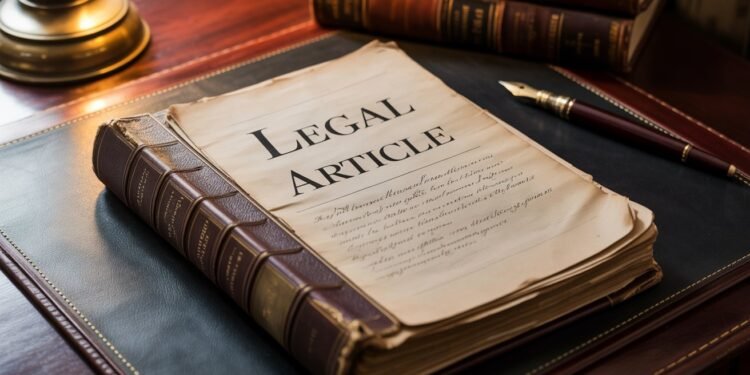Author:
Aratrika Roy Chowdhury, a Law Student, at St. Xavier’s University, Kolkata
Introduction
In today’s digital age, electronic evidence any data created, stored, or transmitted in electronic form has become a central part of legal proceedings. The Supreme Court in Tomaso Bruno & Anr. v. State of U.P. (2015) rightly observed that with the rapid growth of technology, electronic evidence plays a vital role in proving facts, since it can greatly assist investigative agencies. Recognizing this, India’s legislature amended the Evidence Act in 2000 to include electronic documents within its scope.
From emails and CCTV footage to mobile chats and cloud data, digital information now appears regularly in court. However, since such data can easily be altered, copied, or deleted, the courts demand strong proof of authenticity. To ensure this, electronic records are governed by special provisions- Sections 65A and 65B of the Indian Evidence Act.
Section 65A states that the contents of electronic records must be proved according to Section 65B. Section 65B, in turn, lays down the conditions under which a computer-generated record can be admitted as evidence. It treats such data as a document, but only when the requirements are satisfiedchief among them being the certificate under Section 65B(4). This certificate, issued by a responsible oficial, must describe the electronic record, verify how it was produced, and confirm that the computer or device was functioning properly.
Over time, the judiciary’s interpretation of these provisions has evolved through a series of landmark cases. Navjot Sandhu (2005) and Tomaso Bruno (2015) initially allowed flexibility, while Anvar P.V. v. P.K. Basheer (2014) introduced strict compliance. Later, Shafhi Mohammad (2018) relaxed the rule slightly, but Arjun Panditrao Khotkarv. Kailash Kushanrao Gorantyal (2020) reaffirmed the certificate’s mandatory nature. The following discussion traces this judicial journey, explains the statutory framework, and explores the practical challenges and reforms surrounding electronic evidence in India.
Statutory Framework: Sections 65A and 65B
Sections 65A and 65B were introduced by the Information Technology Act, 2000 to deal specifically with electronic records. Section 65A provides that the contents of an electronic record may be proved only as per Section 65B, which elaborates on the process.
Under Section 65B(1), information contained in an electronic record that is printed, stored, or copied on magnetic or optical media is considered a document and is admissible as evidence provided certain conditions are met. These include regular use of the computer., proper functioning during the creation of the record, and that the information was produced during the regular course of activities.
Most importantly, Section 65B(4) requires a certificate from a person in a responsible position who can vouch for the record’s authenticity and the computer’s proper operation. The certificate should identify the record, explain how it was produced, describe the device used, and confirm the system’s reliability.
In essence, when the original electronic device (primary evidence) is unavailable, a secondary copy such as a printout or CD can be admitted only if it is supported by this Section 65B(4) certificate. These provisions together form a complete code governing the admissibility of electronic records, ensuring that courts rely only on verifiable and authentic data.
Judicial Development of Electronic Evidence Rules State (NCT of Delhi) v. Navjot Sandhu (2005): A Flexible Start
The first major case dealing with electronic evidence was Navjot Sandhu, popularly known as the “Parliament Attack Case.” The prosecution sought to introduce call-detail records from telecom servers without a formal Section 65B certificate. The Supreme Court allowed their admission under the general provisions of secondary evidence (Sections 63-65) and ruled that Section 65B was not mandatory. This judgment reflected a pragmatic approach,
acknowledging the practical difficulties of producing entire computer systems in court. Anvar P.V. v. P.K. Basheer (2014): Turning Point Towards Strict Compliance
Nearly a decade later, Anvar P. V. changed the landscape. The Court ruled that Sections 65A and 65B are special provisions and constitute a complete code for electronic evidence. It overruled Navjot Sandhu to the extent it allowed flexibility. The judgment held that no electronic record can be admitted unless it meets all Section 65B requirements, including the certificate under subsection (4). Oral testimony alone was declared insufficient. This decision marked a clear shift toward strict procedural compliance.
Tomaso Bruno & Anr. V. State of U.P. (2015): Partial Return to Flexibility
Surprisingly, in Tomaso Bruno, another three-judge bench reverted to a more lenient approach. Without referring to Anvar, it allowed secondary electronic evidence under the general provisions of Section 65, implying that Section 6SB was not the only route to admissibility. This inconsistency caused confusion among courts and practitioners alike.
Shafhi Mohammad v. State of H.P. (2018): A Narrow Exception
In Shafhi Mohammad, the Court recognized that sometimes the person presenting evidence does not have access to the device from which the record originated. It ruled that in such cases, the absence of a 65B certificate should not automatically bar evidence. The decision introduced a limited exception, treating the certificate as procedural rather than mandatory where compliance was impossible.
Arjun Panditrao Khotkar v. Kailash Kushanrao Gorantyal (2020): Restoring the Rule
Finally, the confusion was resolved in Arjun Panditrao Khotkar. The Supreme Court reaffirmed that the Section 65B(4) certificate is mandatory for admissibility of electronic evidence, overruling Shafhi Mohammad. The Court clarified that if a party cannot obtain the certificate, they must request the court to summon the person or entity in control of the device to produce it. Without such efforts, the evidence cannot be admitted.
Following this ruling, courts have consistently applied a strict interpretation no certificate, no evidence-except in truly exceptional situations. For example, in Kailash v. State of Maharashtra (2025), the Court held that once a valid certificate is produced, video recordings become admissible like any other document, and there is no need to transcribe every detail.
Understanding the Section 65B(4) Certificate
The Section 65B(4) certificate is now recognized as the key to admitting electronic evidence. Courts have clarified that it must cover all technical conditions mentioned in Section 65B(2), such as proper device functioning and authenticity of data. The certificate must accompany the evidence at the time it is presented, though courts may allow some flexibility if there is a valid reason for delay.
In Arjun Panditrao, the Court emphasized that the certificate must address every necessary detail about the record and its production. Once such a certificate is furnished, the record can be treated as primary evidence, eliminating the need for additional oral testimnony.
Practical Challenges in Handling Electronic Evidence
While the legal framework is clear, implementing it in real-world cases presents significant hurdles:
Chain of custody: Electronic data can easily be altered or deleted, so every stagefrom seizure to storage must be documented carefully. Any gap in this chain can render the evidence unreliable.
” Device and data diversity: Evidence may come from computers, smartphones, cameras, or servers. Extracting it safely requires technical expertise; improper handling can lead to accusations of tampering.
Encryption and access: Modern devices use strong encryption, and investigators often need legal permission to access or decrypt data. End-to-end encrypted chats (like WhatsApp) are especially challenging to authenticate.
Cloud and third-party storage: Increasingly, data is stored in cloud servers or social media platforms, often outside India’s jurisdiction. Obtaining and certifying such data requires cooperation from service providers and may involve international legal processes.
Social media evidence: Courts have ruled that screenshots or digital copies of chats or posts are admissible only when accompanied by a proper certificate verifying their source and authenticity. For example, in Rakesh Singla v. Union of India (2021), uncertified WhatsApp chats were deemned inadmissible. Similarly, Virendra Khanna v. Karnataka (2021) stressed that mere presence of chats is not proof of guilt unless corroborated.
These challenges highlight the urgent need for better training, more forensic labs, and standardized procedures. Many Indian police departments lack advanced digital-forensic infrastructure, making compliance difficult. Nevertheless, courts have shown flexibility in interpretation while maintaining the importance of authenticity.
Adapting to Digital Forensics, Cloud, and Social Media Evidence
Indian courts and investigators are gradually modernizing their approach. Digital forensics now plays a crucial role in criminal and civil cases. Investigators are encouraged to use best practices–1ike imaging devices bit-by-bit, verifying hash values, and maintaining secure backups.
The Bharatiya Sakshya Adhiniyam, 2023, which replaces the old Evidence Act, explicitly integrates electronic records throughout its provisions. It redefines “documents” to include digital records and retains the certificate system under Section 63 of the new law, modeled on the old Section 65B.
Courts have also acknowledged the realities of social media and cloud evidence. They often accept authenticated platform records or forensic examiner reports as substitutes for the certificate, provided reliability is ensured. Some courts have even allowed the direct playback of
digital content in court (as seen in Kailash v. Maharashtra, 2025), making proceedings more practical and technology-friendly.
Conclusion
Electronic evidence is now indispensable in the Indian justice system. Over two decades of case law have refined the rules governing its admissibility, culminating in a clear standard: electronic records are admissible only when supported by a valid Section 65B(4) certificate. Exceptions are rare and permitted only when obtaining the certificate is genuinely impossible and the party has sought judicial assistance.
The upcoming Bharatiya Sakshya Adhiniyam, 2023 continues this framework but also modernizes it to reflect current technological realities. Still, more clarity is needed especially regarding foreign based digital evidence and social media content.
Ultimately, the goal of these laws is not to prioritize rigid technicalities but to ensure that justice is based on reliable and authentic digital material. As technology advances, India’s legal system must continue evolving-balancing procedural rigor with practical realities, and ensuring that electronic evidence serves truth rather than complicates it.



